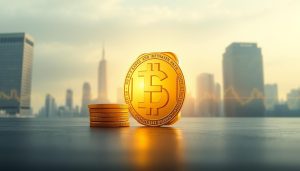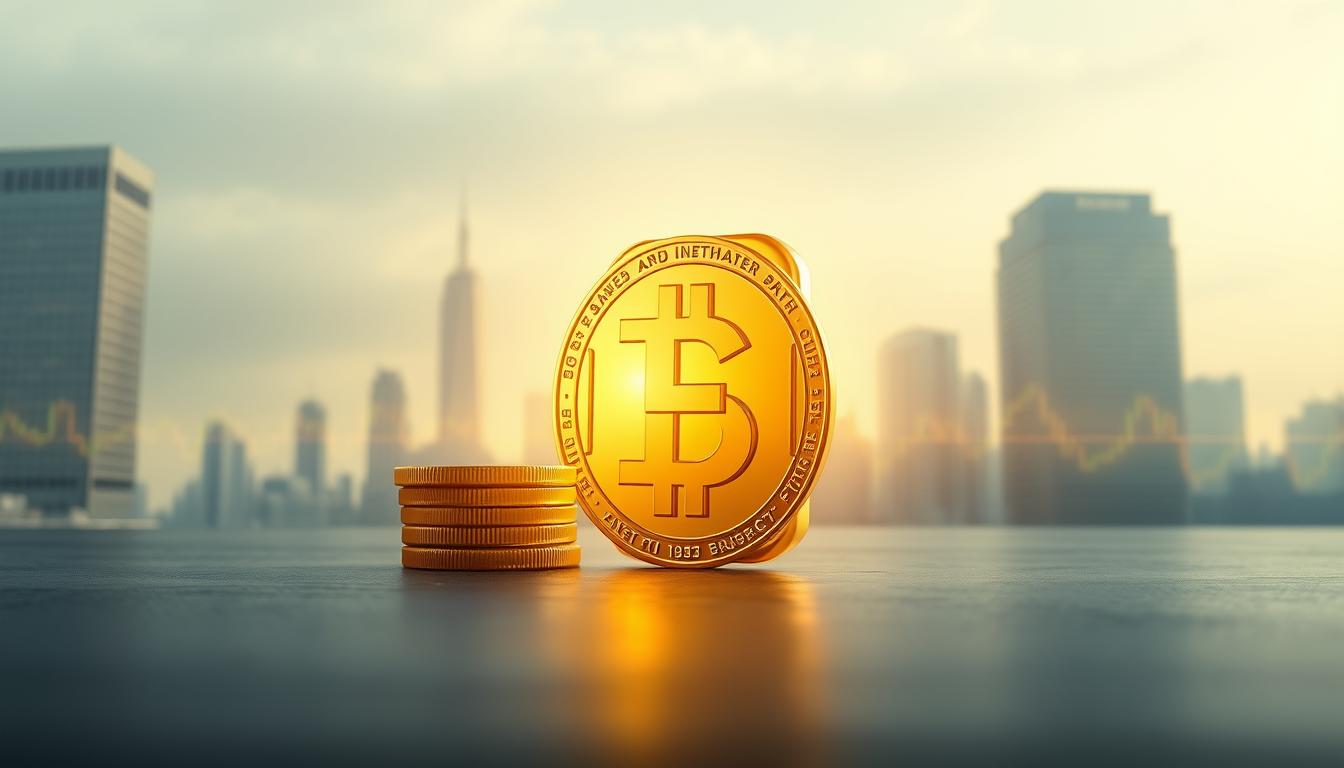As stock market uncertainty and inflation continue to be major concerns for investors, gold has emerged as a popular safe-haven asset. In 2025, the price of gold has hit new all-time highs, attracting even more investors looking to hedge their portfolios.

The surge in gold prices has led to a significant increase in investments in Gold Exchange Traded Funds (ETFs), which offer an easy and efficient way to invest in gold without the need for physical ownership.
Key Takeaways
- Gold prices have hit new highs in 2025 due to market uncertainty and inflation.
- Investors are flocking to Gold ETFs as a safe-haven asset.
- Gold ETFs offer a convenient way to invest in gold.
- The popularity of gold as an investment is on the rise.
- Gold ETFs provide a hedge against stock market volatility.
The Current State of Gold Markets
With gold prices at $3,386.70 per ounce, the market is buzzing. The current state of gold markets is influenced by various global and local factors. Central bank demand, especially from BRICS nations, has driven record gold purchases.
Global Gold Price Trends
The global gold price has shown significant fluctuations in recent times. Recent price movements have been characterized by a steady increase, driven by economic uncertainty and geopolitical tensions.
Recent Price Movements and Patterns
Analyzing recent price movements, we see a pattern of gradual increase punctuated by occasional dips. This pattern is influenced by market sentiment and economic indicators.
Factors Driving Global Gold Prices
Factors driving global gold prices include central bank purchases, investor demand for safe-haven assets, and economic indicators such as inflation rates. As noted by a recent financial report, “The surge in central bank gold purchases has been a key driver of the current gold price rally.”
Indian Gold Market Dynamics
In India, gold holds significant cultural and economic importance. The demand for gold is driven by festivals, weddings, and investment purposes.
Cultural Significance and Demand Patterns
Gold is deeply ingrained in Indian culture, particularly during festivals and weddings. This cultural significance drives demand patterns, with a notable increase in gold purchases during these periods.
Impact of Government Policies on Gold in India
Government policies, including import duties and regulations, significantly impact the gold market in India. As stated by a government official, “Our policies aim to balance the demand for gold with the need to manage foreign exchange reserves.”
Understanding Gold ETFs
Investing in gold has never been easier, thanks to the advent of Gold ETFs, which offer a convenient way to gain exposure to gold without physical ownership. Gold ETFs are designed to track the price of gold, allowing investors to benefit from the fluctuations in the gold market without the need to store physical gold.
What Are Gold ETFs?
Gold ETFs are exchange-traded funds that are backed by gold, either physically or synthetically. They are traded on stock exchanges, just like equities, and their price is derived from the value of the underlying gold.
Structure and Functioning
The structure of Gold ETFs involves holding gold in a vault or through other financial instruments that replicate the performance of gold. The fund is divided into units, which are then traded on the stock exchange.
Underlying Assets and NAV Calculation
The Net Asset Value (NAV) of a Gold ETF is calculated based on the total value of the gold held by the fund, divided by the number of outstanding units. The NAV is typically calculated at the end of each trading day.
How Gold ETFs Work
Gold ETFs work by allowing investors to buy and sell units of the fund, which represent a proportionate ownership in the gold held by the fund. This mechanism provides liquidity and flexibility to investors.
Types of Gold ETFs Available in India
In India, investors have access to various Gold ETFs, each with its unique characteristics. These include physically-backed Gold ETFs and synthetic Gold ETFs that track gold prices.
Popular Gold ETF Options for Indian Investors
Some of the popular Gold ETFs available in India include the SPDR Gold Shares ETF and the iShares Gold Trust. These ETFs are well-established and offer a reliable way to invest in gold.
Expense Ratios and Fund Sizes
When choosing a Gold ETF, investors should consider the expense ratio, which is the annual fee charged by the fund, and the fund size, which indicates the total assets under management. Lower expense ratios and larger fund sizes often indicate a more efficient and stable fund.
Benefits of Gold ETF Investing
Gold ETFs offer a modern approach to investing in gold, providing several benefits to investors. They have become a popular choice due to their unique advantages over traditional gold investment methods.
Portfolio Diversification
One of the primary benefits of Gold ETFs is portfolio diversification. By including Gold ETFs, investors can reduce their dependence on other asset classes, thereby minimizing risk. Gold has historically shown a low correlation with other assets, making it an effective diversification tool.
Liquidity Advantages
Gold ETFs are highly liquid, allowing investors to easily buy and sell units on stock exchanges. This liquidity is a significant advantage, as it enables investors to quickly respond to market changes or financial needs.
Lower Storage and Insurance Costs
Investing in Gold ETFs eliminates the need for physical gold storage, thereby reducing costs associated with insurance and security. This makes Gold ETFs a cost-effective alternative to physical gold investment.
Transparency and Regulation
Gold ETFs are regulated by SEBI, ensuring transparency and investor protection. The regulatory framework provides a secure environment for investors.
SEBI Regulations for Gold ETFs
SEBI regulates Gold ETFs, mandating strict disclosure and operational guidelines to protect investor interests.
Disclosure Requirements and Investor Protection
Gold ETFs are required to disclose their holdings regularly, ensuring transparency and enabling investors to make informed decisions.
The reasons to invest in Gold ETFs are compelling, given their diversification benefits, liquidity, cost-effectiveness, and regulatory oversight. As such, Gold ETFs represent a viable ETF investment strategy for those looking to tap into the gold market.
Gold ETF vs Physical Gold: A Comprehensive Comparison
When considering investment in gold, investors often find themselves torn between gold ETFs and physical gold. Both options have their advantages and disadvantages, which are discussed in detail below.
Cost Considerations
The cost associated with investing in gold ETFs and physical gold differs significantly. Physical gold involves making charges and storage costs, while gold ETFs have management fees.
Making Charges and Management Fees
Physical gold investment involves making charges, which can range from 6-12% of the gold value. In contrast, gold ETFs have management fees that are generally lower, ranging from 0.5-1% of the investment.
Long-term Holding Costs
When holding physical gold, investors need to consider storage and insurance costs, which can add up over time. Gold ETFs, on the other hand, do not require such costs, making them a more cost-effective option in the long run.
Security and Storage
Physical gold requires secure storage, which can be a concern for investors. Gold ETFs, being digital, eliminate the need for physical storage, reducing the risk of theft or loss.
Liquidity and Resale Value
Gold ETFs offer easier liquidity compared to physical gold, as they can be traded on stock exchanges. The resale value of gold ETFs is also more transparent, as their value is directly linked to the gold price.
Tax Implications in India
Investors need to consider the tax implications of both options. Gold ETFs are subject to capital gains tax, while physical gold is subject to capital gains tax and GST.
Capital Gains Tax Structure
Gold ETFs are subject to capital gains tax, with long-term gains being taxed at a lower rate compared to short-term gains.
GST Considerations
Physical gold is subject to GST, which adds to its cost. Gold ETFs, being a digital investment, are not subject to GST.
| Investment Option | Cost | Security | Liquidity | Tax Implications |
| Gold ETFs | Management Fees (0.5-1%) | Digital, No Storage Risk | High, Traded on Stock Exchanges | Capital Gains Tax |
| Physical Gold | Making Charges (6-12%), Storage Costs | Physical, Storage Risk | Low, Resale Value Not Transparent | Capital Gains Tax, GST |
Should We Invest in Gold ETF2025? Analyzing the Prospects
With economic indicators and geopolitical tensions influencing gold prices, the question remains: should we invest in gold ETFs in 2025? As investors weigh their options, it’s crucial to analyze the prospects of gold ETF investments in the coming year.
Economic Indicators Affecting Gold Prices
Economic indicators play a significant role in determining gold prices. Two key factors to consider are inflation outlook and interest rate projections.
Inflation Outlook for 2025
The inflation outlook for 2025 is a critical factor in gold price forecasting. Historically, gold has performed well during periods of high inflation, as it is seen as a hedge against currency devaluation.
Interest Rate Projections
Interest rate projections are another crucial economic indicator. Higher interest rates can strengthen the dollar, potentially dampening gold prices, while lower rates can weaken the dollar, making gold more attractive.
| Economic Indicator | Impact on Gold Prices |
| High Inflation | Positive |
| Low Inflation | Negative |
| High Interest Rates | Negative |
| Low Interest Rates | Positive |
Geopolitical Factors Influencing Gold Markets
Geopolitical tensions and conflicts can significantly impact gold prices. Investors often turn to gold as a safe-haven asset during times of uncertainty.
Recent geopolitical developments have shown that gold prices can be highly responsive to global events, making it essential to monitor these factors closely.
Expert Predictions for Gold in 2025
Experts have varying perspectives on the outlook for gold in 2025. Some predict a bullish trend, while others are more cautious.
Bullish Perspectives
Bullish experts point to potential economic downturns and geopolitical tensions as reasons for gold’s continued growth.
Bearish Considerations
On the other hand, bearish experts argue that improvements in global economic conditions and rising interest rates could dampen gold’s appeal.
In conclusion, the decision to invest in gold ETFs in 2025 should be based on a thorough analysis of economic indicators, geopolitical factors, and expert predictions.
Gold ETF Performance Analysis: Past and Projected
Analyzing the historical performance and projected returns of Gold ETFs can provide valuable insights for investors in 2025. As the gold market continues to evolve, understanding the dynamics of Gold ETFs is crucial for making informed investment decisions.
Historical Performance of Gold ETFs in India
Historically, Gold ETFs have performed well, especially during market downturns. This trend is expected to continue in 2025, making them an attractive option for risk-averse investors.
5-Year Performance Review
Over the past five years, Gold ETFs in India have shown a steady performance, with returns averaging around 10% per annum. This consistency is a testament to the stability of gold as an investment asset.
Performance During Market Downturns
During market downturns, Gold ETFs have typically outperformed other investment options, providing a safe haven for investors. Their performance during such periods underscores their value in a diversified portfolio.
Benchmarking Against Other Investment Options
When comparing Gold ETFs to other investment options, their performance stands out in certain aspects. The following table provides a comparison with equity, debt instruments, and Sovereign Gold Bonds.
| Investment Option | Average Annual Returns | Liquidity |
| Gold ETFs | 10% | High |
| Equity Funds | 12% | High |
| Debt Instruments | 7% | Medium |
| Sovereign Gold Bonds | 8% | Low |
Comparison with Equity and Debt Instruments
Gold ETFs offer a unique blend of liquidity and returns, making them competitive with equity and debt instruments. Their performance is particularly noteworthy during periods of economic uncertainty.
Gold ETFs vs Sovereign Gold Bonds
While Sovereign Gold Bonds offer attractive returns, their liquidity is limited compared to Gold ETFs. Investors seeking flexibility may prefer Gold ETFs over SGBs.
Projected Returns for 2025
Based on current trends and market analysis, Gold ETFs are expected to continue their strong performance in 2025. Investors can anticipate returns in line with historical averages, making Gold ETFs a viable long-term investment option.

How to Buy Gold ETFs in India
To invest in Gold ETFs, Indian investors need to follow a straightforward process that begins with opening a demat account. A demat account is essential for holding Gold ETFs in electronic form, eliminating the need for physical storage.
Opening a Demat Account
Opening a demat account is the first step towards investing in Gold ETFs. This account is used to hold securities in electronic form.
Required Documentation
To open a demat account, investors need to provide basic documentation, including PAN card, Aadhaar card, and proof of address.
Choosing the Right Broker
Selecting a reputable broker is crucial. Investors should compare brokerage charges, services, and user reviews to make an informed decision.
Selecting the Right Gold ETF
Once the demat account is active, investors need to choose a suitable Gold ETF. Popular Gold ETFs in India include SPDR Gold MiniShares Trust.
Evaluation Criteria for Gold ETFs
Investors should evaluate Gold ETFs based on factors like expense ratio, tracking error, and liquidity.
Top-Performing Gold ETFs in India
Some of the top-performing Gold ETFs in India have consistently delivered strong returns. Investors should research and compare these ETFs before investing.
Investment Strategies for Different Investor Profiles
Investors can adopt different strategies based on their financial goals and risk tolerance.
Lump Sum vs Systematic Investment
Investors can choose between lump sum investment and systematic investment plans (SIPs), depending on their investment preferences.
Ideal Allocation Percentages
The ideal allocation to Gold ETFs varies, but a common range is between 5-10% of the total investment portfolio.
| Investment Strategy | Ideal for | Risk Level |
| Lump Sum | Investors with a large corpus | High |
| Systematic Investment | Investors preferring regular investments | Moderate |
Risks and Challenges of Gold ETF Investments
The risks associated with Gold ETF investments are multifaceted and require careful evaluation. Investors must be aware of the various challenges that come with investing in Gold ETFs.
Market Volatility Concerns
Gold ETFs are subject to market volatility, which can lead to significant price fluctuations. Short-term price fluctuations can be particularly challenging for investors with a short-term perspective.
Short-term Price Fluctuations
These fluctuations are often driven by market sentiment and macroeconomic factors.
Currency Risk Factors
Additionally, currency risk can impact Gold ETF prices, especially for investors holding different currencies.
Tracking Error Issues
Tracking error is another significant risk associated with Gold ETFs. It occurs when the ETF’s performance deviates from its underlying asset.
Causes of Tracking Errors
Tracking errors can be caused by various factors, including management fees and operational expenses.
Minimizing Tracking Error Impact
Investors can minimize the impact of tracking errors by choosing ETFs with low expense ratios.
Regulatory and Policy Risks
Gold ETF investments are also subject to regulatory and policy risks. Changes in tax policies or import duties can affect the attractiveness of Gold ETFs.
Potential Tax Policy Changes
Potential changes in tax policies can impact the returns on Gold ETF investments.
Import Duty Implications
Import duty changes can also influence the price of gold and, consequently, Gold ETF prices.
Conclusion
As we analyze the prospects of gold ETF investment in 2025, it’s essential to consider the current gold market trends and the benefits of investing in gold ETFs. The global gold price trends and Indian gold market dynamics indicate a potential for growth, making gold ETFs an attractive investment option.
Based on the analysis of economic indicators and geopolitical factors influencing gold prices, investors can make an informed decision about gold ETF investment in 2025. The historical performance of gold ETFs in India and projected returns for 2025 also provide valuable insights for investors.
When considering should we invest in gold ETF 2025, it’s crucial to weigh the benefits, including portfolio diversification, liquidity advantages, and lower storage costs. However, it’s also important to be aware of the risks, such as market volatility and tracking error issues.
In conclusion, investing in gold ETFs can be a prudent decision for 2025, given the right investment strategy and risk management. By understanding gold market trends and making an informed investment decision, investors can potentially benefit from the growth of the gold market.

